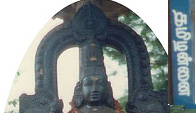
 |
||
| Home Grammar Lessons > Introduction I 1 2 3 4 5 6 II 1 2 3 4 5 6 III 1 2 3 4 5 6 IV 1 2 3 4 5 6 V 1 2 3 4 5 6 VI 1 2 3 4 5 6 Select Unit | ||
|
| ||
Adjectives and AdverbsTamil has very few inherent adjectives. Instead, adjectives are formed by adding certain suffixes onto nouns or verbs. The most commonly used adjective suffixes are ஆன and அ. The suffix ஆன is used to make adjectives out of nouns and அ out of verbs. Adjectives derived from nounsIn both written and spoken Tamil, adjectives are formed from nouns by adding ஆன to the noun.
2nd pers-polite a/one height-adj person/man 'You are a tall person'. Adding adjective suffixes with nouns follow regular sandhi rules as discussed earlier.
which temple beauty-adj. temple 'which temple is a beautiful temple?' Even adjectives like நல்ல 'good', பெரிய 'big' etc., which may sound like a separate word without any declension, but they are historically derived from the root நல் 'good-ness (noun)' and பெரி 'big-ness (noun)' respectively, but these root noun forms are not used in modern Tamil as such. இது நல்ல புத்தகம் this (noun) good book 'This is a good book.' அது பெரிய வீடு
The pronouns அது, இது and எது have their corresponding derived form of adjectives as அந்த, இந்த and எந்த respectively. இந்த வீடு உங்கள் வீடா? அந்த வீடு உங்கள் வீடா?, எந்த வீடு உங்கள் வீடு? 'Is this your house?', or 'that house your house?'. 'Which house is your house?'. The possessive form of nouns also act as adectives, and they can be expressed optionally with the suffix உடைய as in யாருடைய வீடு இந்த வீடு? 'Whose house is this house? In some cases, nouns denoting 'colors', 'days' act as an adjective merely by occuring before another noun. 'The green shirt is my shirt and the black shirt is your shirt. இன்றைக்குத் திங்கள் கிழமை.
அம் ending nouns can be used as adjective with the final ம் removed
பணக் காரர் 'rich person' (பணம் > பண-). NB: When the following letter is a stop consonant, it is duplicated with the adjective as noted here. Adjectives made from verbs using the suffix அVerbal adjectives, otherwise called Adjectival participles (AJP, see unit 6, lesson 4), are made using the suffix அ added with tense form of verbs (i.e. verb root-tense-அ).
see-pst-adj(அ) boy 'the boy who saw' படிக்கிற தம்பி 'the younger brother who studies'
The future tense form of adjectives are made using the suffix உம்:
sing-fut neut-parrot 'singing parrot' நாளைக்கு வரும் அப்பா
Adverbs made from nouns with the suffix ஆகLike adjectives, adverbs can be made from nouns by adding the suffix ஆக.
நான் ஆசிரியரா இருக்கேன் (ஆசிரியர் + ஆ) (spoken) 1st pers. teacher-adv. be-pres-1st pers. 'I am a teacher' Like adjectives formed from nouns, adverbs formed from nouns follow Sandhi rules.
You-polite peace-adv. sleep-imperative pol. 'Sleep peacefully'. SupplementSome notes on the phonetics of spoken TamilAs we have already noted, spoken Tamil and written Tamil vary to some degree. However, with respect to phonological form (the pronunciation) they are related in a number of ways. In this textbook we often give both the spoken and written Tamil in written form, (cf. rendering spoken English when writing, wanna lurn?). However, given the Tamil script, not all of these changes can be documented (e.g., nasalized vowels). Below, we will note some of specific features of spoken Tamil and how it differs with respect to written Tamil. There are a number of other systematic rules relating to specific forms (e.g., the present tense, aspectual verbs, etc.). These will not be dealt with here, but in their respective grammar lessons. I. In spoken Tamil, when high short vowels (உ, இ) appear at the beginning of a word (are in the first syllable) and are followed by a single consonant and அ (i.e. the consonant isn't double, cf. க்க), then the high vowel becomes a mid-vowel.Thus இ --> எ and உ-->ஒ. For example,
உனக்கு-->ஒனக்கு 'to you (impolite)' நினை-->நெனெ 'think'
II. As we saw above, in general, ஐ becomes எ in spoken Tamil.
III. Words that end in a vowel plus a nasal generally drop the final nasal and nasalize the vowel.
நான் இருக்கிறேன் 'naan irukkireen'--> 'naa??? irukkre??? (nasalized a, nasalized e) 'I am' அவன் 'avan'--> 'ava???' (nasalized a) 'He'
IV. Words that end in an ல், ள் undergo one of two changes depending on how many syllables are in the word.
பல் 'pal'--> பல்லு 'pallu' milk If the middle vowel is long, then the final consonant is not doubled, but a உ is still added.
If the word has more than one syllable then the final letter is dropped.
Note that these rules apply when the word is in isolation. But if some other suffix is added the word, this final letter reappears. For example,
V. There are also a number of changes tha to occur to certain consonant combinations.
த்த் after இ or ஐ becomes ச்ச். ந்து or ய்த் after இ or ஐ becomes ஞ்ச்
செய்து-->செஞ்சு 'having done' தெரிந்தது-->தெரிஞ்சது 'knew' Generally clusters of three (or more) consonants are reduced to two.
பார்த்தாள்-->பாத்தா 'She saw.'
|
|
© South Asia Language Resource Center (SALRC) |